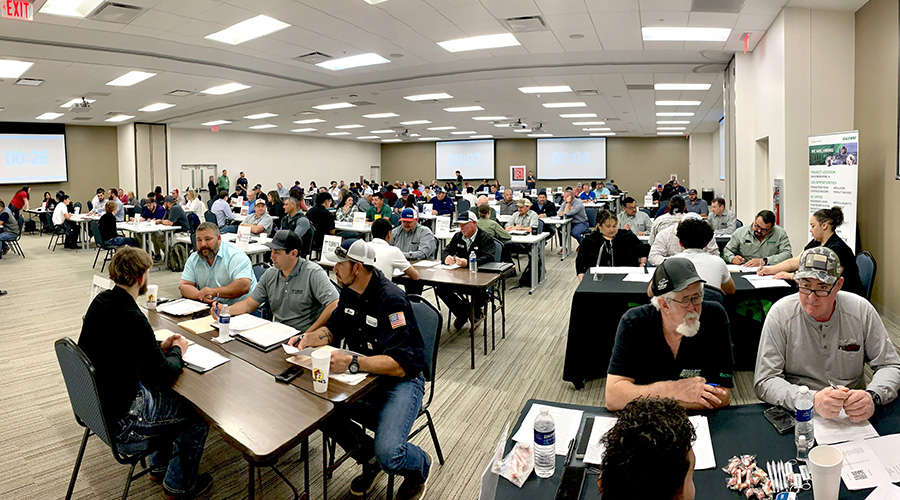How to Make Outsourcing Work for Your Facility
By understanding work scope, personnel considerations and onboarding, owners and managers can deliver successful projects.
By Dan Hounsell, Senior Editor
Outsourcing in institutional and commercial facilities is a complex process. From setting the scope of the work to selecting a service provider to overseeing the project from beginning to end, building owners and managers must make a series of critical decisions, each of which go a long way in determining the project's ultimate success.
For as challenging as these elements of the process can be, the toughest element of successful outsourcing goes well beyond mastering the mechanical components to understanding and incorporating the human element.
"If you’ve done your vetting correctly, you’re hiring people who know how to do the stuff,” says Eric Hoffman, vice president and national healthcare sector lead with Project Management Advisors, adding, “The soft skills I'm talking about are the difference makers in how to be successful. A lot of highly competent technical people are really bad at moving things forward because they can’t get the lay of the land. They can’t traverse through decisions and different decision groups."
Early steps to success
Even before selecting an outsourcing partner, owners and managers face a critical task that many fail to address properly: setting expectations.
"One of the biggest mistakes that owners make is they don't lay down their expectations and what they really want,” says Michael Heroux, an energy engineer with FST Technical Services. “They need to develop that before they get to the point of even looking for a contractor. That’ll screen out a lot of applicants that might not have the staffing or the capabilities that they're looking for.”
Unfortunately, many owners and managers do not place a high enough priority on this task, in part because they might not be as familiar with technology and equipment as they are with business.
"It depends on (facilities managers’) function and their capabilities,” Heroux says. “Some of them are more from the business side of the facility world. They’re worried about managing the budget and making sure the customer is taken care of. I don't know if they’ve got the engineering or the maintenance background to figure out what they really need. Sometimes, that becomes a problem.”
To effectively set expectations for the project, owners and managers can start by fully understanding the project itself.
"You need to know the complexity of your project and the size of it dollarwise,” says Greg Shannon, director of construction operations with Henderson Building Solutions. “Financially, you do not want to get into a subcontractor or a consultant that doesn’t have the financial capacity to handle the size of the project.”
As is the case with setting project expectations, owners and managers are more likely to deliver a successful project if they also take time to carefully screen potential service providers. Unfortunately, too few do so.
“Owners aren’t very good about spending the time to check references specifically beyond the ones that are given to them that are handpicked by the candidates,” Hoffman says. “For the most part, it’s time, as well as having somebody on their team that they can delegate some of that upfront research to. They can have a younger team member do that investigation. They may not be able to make the senior management call, but they can rough it out so I can add value in a more efficient way.”
While project scope and personnel issues are important elements of a successful project, perhaps the most perilous consideration owners and managers face when selecting an outsourcing provider is the issue of cost.
"You have to be budget conscious, but always selecting the low price sometimes is great,” Shannon says. “You’ve got to communicate with whoever that subcontractor is. When you get multiple proposals, you have to look at all of the proposals, not just the high one or the low one. One of the mistakes you make are that you look at that low dollar and say, ‘This is my guy.’”
Another personnel decision owners and managers should address early in the project is taking steps to build an effective project team.
“One thing I would do is try to get your project team involved as early as possible,” Shannon says. “You don’t want to go, ‘I've selected project team A. They're my guys, and we need to start this in two weeks.’ That’s setting it up for failure. Build the relationship with the contractor and the owner or the designer. Whoever it is, get them involved as early as possible.”
Management matters
The challenges of outsourcing are hardly over after an owner or manager selects a partner. They still must handle a series of complex management issues that are essential for a project’s success. The first of these requires owners and managers to assess the ability of the service provider to dovetail with the organization’s workplace culture.
“While communication is incredibly important, it is equally important to align with the culture of the institution that you're working with,” Shannon says. “There are a lot of people who know what to do, how to build things, how to move projects along. But if they’re going to be a jerk about it and are not going to fit culturally within your institution, it’s going to be really difficult for them to be successful.”
One process that can help a contractor work effectively with the in-house staff is giving them adequate information on the facility’s systems and processes early enough so they can understand it.
"Almost universally, people do a bad job of onboarding,” Shannon says. “There is work involved in saying, ‘Your first day starts in a month. Here's what you want to be reading before. Here’s our structure. Here’s all the documents that we put together in a hierarchical and comprehensive fashion to help bring you on board.’”
Because outsourcing involves having outside technicians work on unfamiliar equipment and systems, owners and managers also need to ensure technicians make time to familiarize themselves with the building components in question.
“They often don’t do a thorough walkthrough of the equipment to identify what you have to make sure that they understand the expectations of the service level,” Heroux says, adding that continuity with contracted technicians also is important. “Don’t send me a different technician every time to show up on my site because after you go through the process of getting them to know where to get access to the equipment, where the equipment is, procedures of our site. If you bring a different technician every time, it becomes problematic for continuity.”
As owners and managers rely more than ever on facilities data to understand their facilities’ condition, performance and efficiency, they need to ensure that outsourcing providers play their part. Specifically, they need to capture facility data generated by the service provider.
“Owners need to ask, ‘How do I get this information into the computerized maintenance management system?” Heroux says, referring to a CMMS. “That's one of the biggest problems because a lot of these (outsourcing) companies have their own system that tracks it. I need to get this stuff into my system.”
He says one potential solution is to give the contractor access to the organization’s CMMS to enter the data in the system.
“That way, when we go to look at that air handler, I can say, ‘That technician just did preventive maintenance in January, and everything’s good.’ I can track it. That’s one of the hardest things to get accomplished, and it needs to be in the service agreement.”
Making outsourcing work
Outsourcing most often involves a scope of work and schedule that are laid out well in advance to give owners, managers and service providers time to plan and prepare. But nature does not have a schedule.
Well before the arrival of a natural disaster or other emergency that might affect a facility’s operations, owners and managers can tap into the relationships they have with outsourcing partners to determine whether they can rely on that resource in a crisis.
“The question I would always ask each one of them is, ‘If we have a major storm that comes through and does damage all through the area, what are your capabilities to handle that?’: Heroux says. “The question then comes down to whether you can handle it knowing that it might take them two weeks to get to you. They might have 150 customers in that area, and they’ve got 15 technicians. They can't service everybody at the same time at the level that customers are going to request.
In such situations, owners and managers need to truly understand the requirements of their facilities.
“Maybe you can live with one building going down for a week or two weeks, but you’ve got a library that has $20 million worth of rare books and art and critical systems,” Heroux says. “The question becomes, ‘If I can't find contractor to service it, am I better off having some backup capability?’ Or can you say to the contractor, ‘What if I pay a premium to make sure I have service needed within so many hours or days?’”
Ultimately, the success or failure of an outsourcing project rests on the ability of an owner or manager to effectively juggle all of these issues.
“It’s being cognizant of the life cycle of this exercise and thinking about how you're going to manage it,” Shannon says. “Somebody has to own it."
Dan Hounsell is senior editor for the facilities market. He has more than 30 years of experience writing about facilities maintenance, engineering and management.
Related Topics:












